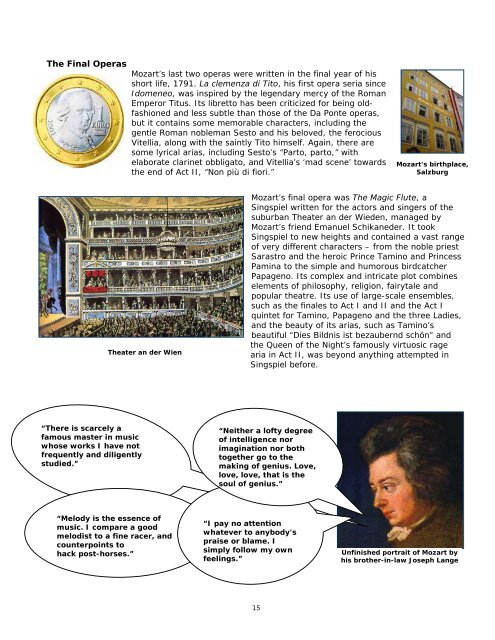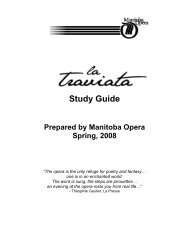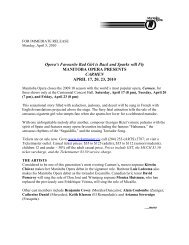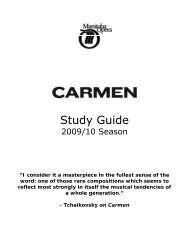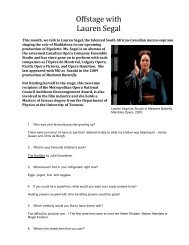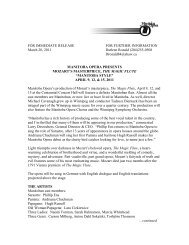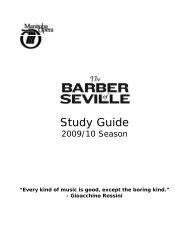The Magic Flute Study Guide - Manitoba Opera
The Magic Flute Study Guide - Manitoba Opera
The Magic Flute Study Guide - Manitoba Opera
Create successful ePaper yourself
Turn your PDF publications into a flip-book with our unique Google optimized e-Paper software.
<strong>The</strong> Final <strong>Opera</strong>s<br />
“<strong>The</strong>re is scarcely a<br />
famous master in music<br />
whose works I have not<br />
frequently and diligently<br />
studied.”<br />
Mozart’s last two operas were written in the final year of his<br />
short life, 1791. La clemenza di Tito, his first opera seria since<br />
Idomeneo, was inspired by the legendary mercy of the Roman<br />
Emperor Titus. Its libretto has been criticized for being oldfashioned<br />
and less subtle than those of the Da Ponte operas,<br />
but it contains some memorable characters, including the<br />
gentle Roman nobleman Sesto and his beloved, the ferocious<br />
Vitellia, along with the saintly Tito himself. Again, there are<br />
some lyrical arias, including Sesto’s “Parto, parto,” with<br />
elaborate clarinet obbligato, and Vitellia’s ‘mad scene’ towards<br />
the end of Act II, “Non più di fiori.”<br />
<strong>The</strong>ater an der Wien<br />
“Melody is the essence of<br />
music. I compare a good<br />
melodist to a fine racer, and<br />
counterpoints to<br />
hack post-horses.”<br />
Mozart’s final opera was <strong>The</strong> <strong>Magic</strong> <strong>Flute</strong>, a<br />
Singspiel written for the actors and singers of the<br />
suburban <strong>The</strong>ater an der Wieden, managed by<br />
Mozart’s friend Emanuel Schikaneder. It took<br />
Singspiel to new heights and contained a vast range<br />
of very different characters – from the noble priest<br />
Sarastro and the heroic Prince Tamino and Princess<br />
Pamina to the simple and humorous birdcatcher<br />
Papageno. Its complex and intricate plot combines<br />
elements of philosophy, religion, fairytale and<br />
popular theatre. Its use of large-scale ensembles,<br />
such as the finales to Act I and II and the Act I<br />
quintet for Tamino, Papageno and the three Ladies,<br />
and the beauty of its arias, such as Tamino’s<br />
beautiful “Dies Bildnis ist bezaubernd schön” and<br />
the Queen of the Night’s famously virtuosic rage<br />
aria in Act II, was beyond anything attempted in<br />
Singspiel before.<br />
“Neither a lofty degree<br />
of intelligence nor<br />
imagination nor both<br />
together go to the<br />
making of genius. Love,<br />
love, love, that is the<br />
soul of genius.”<br />
“I pay no attention<br />
whatever to anybody's<br />
praise or blame. I<br />
simply follow my own<br />
feelings.”<br />
15<br />
Mozart's birthplace,<br />
Salzburg<br />
Unfinished portrait of Mozart by<br />
his brother-in-law Joseph Lange


